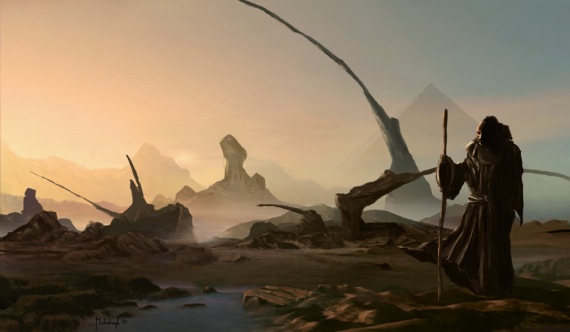
Upper Lands

The most desolate region of the Southlands of Shardar has to be the area of
hills and moors known as the Upper Lands. Storms
out of the Sea of Despair blow across this forbidding area, bringing a chill
wind that murmurs of doom and despondency in the night.
The cruel and unforgiving soils will grow nothing but the hardiest of
shrubs and trees and the animals that roam the land are fierce and deadly.
Virtually
all the Upper Lands are empty hills where few plants and even fewer animals can
be found. The heather that covers
the land makes it surprisingly beautiful, but even this beauty can not tempt
many settlers to attempt to cultivate it. There
are virtually no human settlements, apart from some small fishing villages on
the coasts and even these are few and far between.
Any
community that tries to settle in the Upper Lands will not only have the foul
weather and terrible growing conditions to contend with, but there are always
the Raiders who dwell on the islands above the Sea of Despair as well.
These fierce and war-like people raid Southwards every spring and summer
and they leave a trail of death and destruction behind them.
The fur clad and axe wielding murderers will fall on a community from the
sea and steal or destroy everything that they can.
They seem to take a delight in causing pain and hardship and many people
have said that the Raiders must be Demon possessed to act as they do.
One of the
few animals that roam the Upper Lands is the Giant White Stag.
This noble animal can reach up to eight feet at the shoulder and the head
and huge antlers can easily add another six feet to that height.
The White Deer are not quite as large as their male counterparts but they
are still fast and strong and are no easy target for a hunter.
The Stags are dangerous beasts that must be treated with respect at the
very least. Normally they will flee
at the sight of humans but, on rare occasions, they will turn and attack.
This is more common if they have females or young to protect or if it is
in the rutting season.
There is a
legend of a Lord of Shardar, long before the time of the joining of the
Northlands and the Southlands, who managed to tame one of these Giant White
Stags and would ride the beast to war. The legend says that anyone who can tame and befriend such a
beast will forever be able to call upon the faerie kin of Shardar to aid them
and that the Stag will be a loyal companion until the day the rider dies.
Few people believe this ancient tale and fewer still are willing to try
to find out the truth of it. There
are certain Lords and Barons who would be willing to pay a high price for
captured Stag and an even higher price for a young one that could be
trained.
Another
ancient legend refers to a mine that runs deep below the Upper Lands and this
mine is reputed to contain seams of solid gold.
According to the legend, the mine was abandoned when the miners found a
strange, mist-like creature that floated out of the depths of the earth.
The touch of the creature brought instant death to anyone who was
unfortunate enough to get close to it and if the creature breathed upon you, you
would fall deeply asleep for a hundred years.
After dozens of losses and deaths, the mine was closed and the mouth of
it was caved in. Once again, there
is no evidence to support this story but it still causes a few hardy prospectors
to search around the Upper Lands in the hope of finding their fortune.
There is
currently a tale being spread about by the bards and gossip-mongers that there
is some kind of spirit that walks across the moors at nights.
The bards say that the spirit cries out for the return of what was stolen
from it and offers great rewards for the one who returns it and death to those
who stole it. It is likely that
this is just another fire-side tale, created to hurry away a winterís night,
but it is just possible that there is some truth to the rumours.
The Upper
Lands are claimed by no Lord so there are no taxes for anyone who wishes to
settle there. This has brought a
few people to try to live there, mostly in small crofts, but very, very few
manage to stay and those that do are in a constant battle with the elements and
the land simply to survive. The
benefit of avoiding paying tax is simply not worth the hardships of the lands as
far as most people are concerned.